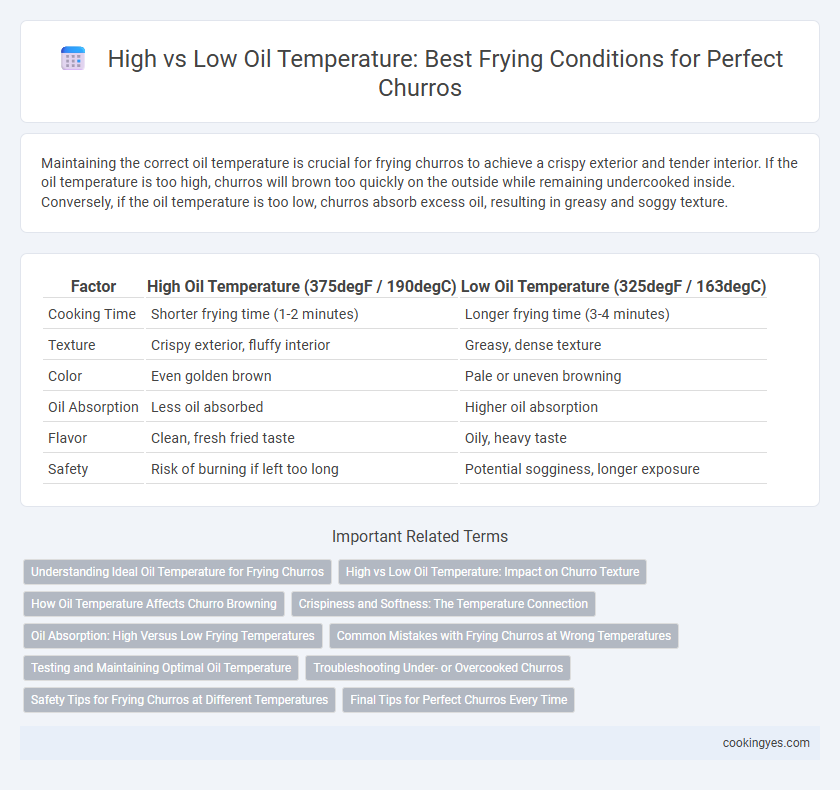Maintaining the correct oil temperature is crucial for frying churros to achieve a crispy exterior and tender interior. If the oil temperature is too high, churros will brown too quickly on the outside while remaining undercooked inside. Conversely, if the oil temperature is too low, churros absorb excess oil, resulting in greasy and soggy texture.
Table of Comparison
| Factor | High Oil Temperature (375degF / 190degC) | Low Oil Temperature (325degF / 163degC) |
|---|---|---|
| Cooking Time | Shorter frying time (1-2 minutes) | Longer frying time (3-4 minutes) |
| Texture | Crispy exterior, fluffy interior | Greasy, dense texture |
| Color | Even golden brown | Pale or uneven browning |
| Oil Absorption | Less oil absorbed | Higher oil absorption |
| Flavor | Clean, fresh fried taste | Oily, heavy taste |
| Safety | Risk of burning if left too long | Potential sogginess, longer exposure |
Understanding Ideal Oil Temperature for Frying Churros
Maintaining the ideal oil temperature between 350degF and 375degF is crucial for frying churros to achieve a crispy exterior and a tender, doughy interior. Oil that is too hot causes the churros to brown rapidly on the outside while remaining undercooked inside, leading to a burnt taste and uneven texture. Conversely, oil at too low a temperature results in greasy, soggy churros due to excessive oil absorption and insufficient crisping.
High vs Low Oil Temperature: Impact on Churro Texture
High oil temperature for frying churros creates a crispy exterior while sealing the dough, preventing excessive oil absorption and resulting in a light, airy interior. Low oil temperature causes churros to absorb more oil, making them greasy and heavy with a dense texture. Maintaining oil temperature around 180degC (356degF) ensures optimal balance between crunchiness and fluffiness.
How Oil Temperature Affects Churro Browning
Maintaining the correct oil temperature between 350degF and 375degF ensures optimal browning and texture when frying churros, as too high a temperature causes rapid browning and burnt exterior while leaving the interior raw. Conversely, oil that is too low below 320degF results in pale, soggy churros that absorb excess oil, compromising crispness and flavor. Proper temperature control promotes even Maillard reaction development, producing golden-brown churros with a crunchy crust and tender inside.
Crispiness and Softness: The Temperature Connection
Frying churros at high oil temperatures around 375degF (190degC) ensures a crispy exterior by rapidly sealing the dough surface, preventing excess oil absorption while maintaining a soft, fluffy interior. In contrast, lower temperatures near 325degF (160degC) cause the dough to absorb more oil, resulting in a greasy texture with reduced crispiness and a denser interior. Optimal temperature control is crucial for achieving the perfect balance between a crunchy crust and a tender, airy inside.
Oil Absorption: High Versus Low Frying Temperatures
Frying churros at high oil temperatures (around 190degC/375degF) minimizes oil absorption, resulting in a crispier texture and less greasy final product. Lower frying temperatures (below 160degC/320degF) cause the churros to absorb more oil due to longer cooking times, yielding a heavier, oilier snack. Maintaining optimal oil temperature enhances churro quality by balancing exterior crunch and interior moisture without excessive greasiness.
Common Mistakes with Frying Churros at Wrong Temperatures
Frying churros at low oil temperatures causes excessive oil absorption, resulting in greasy, soggy pastries that lack the characteristic crisp exterior. High oil temperatures lead to rapid browning of the churro's outside while leaving the inside undercooked and doughy. Maintaining an optimal oil temperature around 350degF (175degC) ensures even cooking, a crispy texture, and prevents common mistakes like burning or oil saturation.
Testing and Maintaining Optimal Oil Temperature
Maintaining oil temperature between 350degF and 375degF is crucial for achieving crispy and evenly cooked churros. Testing oil temperature with a deep-fry thermometer or by dipping a small piece of dough helps ensure optimal frying conditions. Regularly monitoring and adjusting heat prevents oil from becoming too hot, which causes burning, or too cool, leading to greasy and undercooked churros.
Troubleshooting Under- or Overcooked Churros
Oil temperature plays a critical role in achieving perfectly cooked churros; frying at a low temperature causes them to absorb excess oil, resulting in soggy, undercooked interiors. Conversely, excessively high oil temperatures quickly burn the exterior while leaving the inside raw, creating overcooked and uneven textures. Maintaining an optimal frying temperature between 175-190degC (350-375degF) ensures churros develop a crisp, golden crust with a fully cooked, tender inside.
Safety Tips for Frying Churros at Different Temperatures
Maintaining the oil temperature between 350degF and 375degF ensures churros cook evenly, reducing the risk of oil splatters and burns caused by excessively hot oil. Frying at low temperatures below 325degF leads to greasy, undercooked churros that absorb excess oil, increasing the chance of dangerous splattering when moisture contacts hot oil. Utilizing a reliable deep-fry thermometer and never leaving the fryer unattended are essential safety practices for preventing fire hazards and achieving crispy, golden churros.
Final Tips for Perfect Churros Every Time
Maintaining the oil temperature between 350degF (175degC) and 375degF (190degC) ensures churros cook evenly, achieving a crispy exterior without absorbing excess oil. Oil that's too hot causes rapid browning and burnt outside with raw inside, while too low a temperature results in greasy, soggy churros. Use a deep-fry thermometer to monitor and adjust heat precisely for consistently perfect churros every time.
Oil temperature high vs low for frying churros Infographic

 cookingyes.com
cookingyes.com